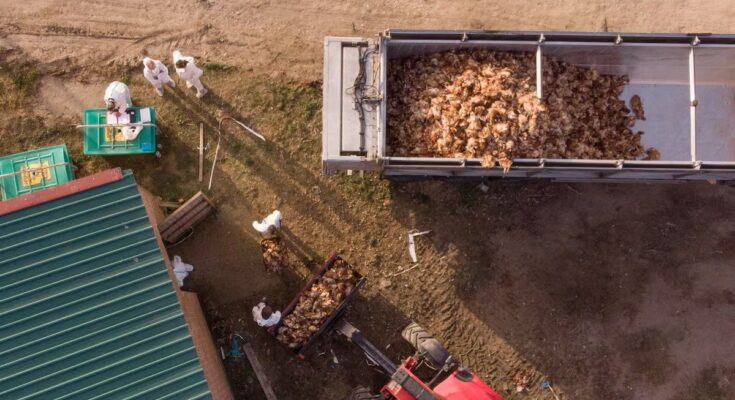Bird flu returns to Spain and worsens the situation of a livestock sector that is still battling nodular skin disease (NCD), which has forced the slaughter of thousands of cattle. In 2022, Spain detected 36 outbreaks of avian influenza. Since then, the N5N1 subtype virus had not experienced an expansion of these characteristics in Spanish territory. According to the latest data from the Ministry of Agriculture, Fisheries and Food (MAPA), in just three months 14 outbreaks were detected in poultry, another five in captive birds and 68 in wild birds. The increase in cases has forced the sacrifice of 2.7 million laying hens and the poultry sector, with the Christmas period upon us, fears that the losses will be astronomical. Both the egg and poultry meat sectors are trying to cope with the social alarm resulting from the tightening of measures by the Government, which this week extended the confinement announced last Monday to all birds, including those coming from self-consumption and organic farming.
The massive sacrifices caused a significant reduction in supply and an increase in prices just a few days before the start of the Christmas campaign. The Poultry Federation of Catalonia (FAC) has warned that if the situation worsens, “the losses could be terrible”. The poultry industry calls for calm and tries to reassure society. They assure that it is an “animal health problem”, not “public health”. Although manufacturers’ forecasts are positive, they confirm that the recovery of normality will be slow. “It will take almost a year for the supply to normalize. It is the time needed for farms to progressively recover both economically and emotionally, since it has a huge implication on the personal lives of farmers who, for the most part, are family businesses that dedicate their lives to animals”, complains the Spanish Federation of Producers of Eggs and Egg Products (Federovo).
The passage of avian influenza through Spain has had an exponential impact on the price of eggs, the cost of which in the shopping cart has increased by an average of 31% in the last year, according to data from the Ministry. Although the price of eggs has been on an upward trend for the past three years due to a general imbalance between supply and demand, the impact of bird flu has only triggered it. It became 22.5% more expensive in October, according to CPI data released this week by the INE. The industry is now working to stabilize the market. “Now the priority is to ensure national supply. Spain is 120% self-sufficient in eggs and usually exports around 20%, which allows exports to be temporarily adjusted to give priority to the national market,” the federation emphasizes.
Both the employers’ association and the department led by Luis Planas appreciate the resilience of the Spanish poultry market in the face of this type of situation, as it is not the first time that the sector has faced such a scenario. It should be remembered that in August China vetoed imports of Spanish poultry products after the discovery of the first outbreaks in Badajoz and Toledo. The director general of Health of Agri-Food Production and Animal Welfare, Emilio García Muro, warned that the Ministry’s guidelines are a “wake-up call” to the sector and the competent authorities to strengthen the biosecurity of farms. “We will evaluate week by week and as soon as we see that the map is much better, the measures will be reduced until we save the situation. We will look for proportionality between good risk control and economic activity,” he said after the ordinance was published.
At the end of March, when the price escalation began, Minister Planas emphasized that the causes of the price increase were multifactorial. On the one hand, due to the impact of avian influenza in the United States and some countries of the European Union, where 645 outbreaks have been reported in the last year, most of them in the United Kingdom, the Netherlands and Germany. The increase in consumption instead increased by 4.2% and the census of laying hens increased by only 0.3%. The poultry meat sector, on the other hand, is less vulnerable to avian influenza because 97% of Spanish production comes from closed farms that already follow European and Spanish guidelines. The price of chicken is on average 6.7% higher than the same period last year.

Cristina Bech, mayor of Castelló d’Empúries (Alt Empordà) and poultry entrepreneur, owns 1,400 free-range laying hens and 25,000 chickens, collects around 1,200 eggs a day and sells them to private individuals, restaurants and shops. Since the first case of avian influenza was detected in Catalonia in February 2017 – the second in Spain – in the Aiguamolls de l’Empordà Natural Park, in its municipal territory, its chickens have been “in preventive isolation” from September to January, due to the risk of being infected by a migratory bird. This year the confinement occurred earlier, in August, “because wild birds were found in the Aiguamolls and since we are within a 10 kilometer radius, they confined us as a precaution.”
Cases detected in 2017 forced the sacrifice of over 7,000 chickens and 17,300 ducks. For Cristina “now the risk of avian flu is especially present during the seasonal changes because the birds migrate and it is the most delicate moment”. Cristina confesses that they have been in this situation for so many years due to avian flu, that the concern is less than for Lumpy Dermatosis. The DNC entered Spain through its municipality and four neighboring farmers had to empty all their facilities and slaughter all their animals.

“In Catalonia we have been following the protocol since 2017 and in dangerous areas we close preventively, regardless of the fact that the Ministry has decided to close all farms in Spain. This means that free-range or organic chickens cannot leave the facilities where they have a home, water, food and nests to lay their eggs, from where they go directly to a conveyor belt,” he explains. The impact in Catalonia was less than in other areas because 63% of poultry farms are used for meat production in closed facilities.
Castilla y León suffers the worst consequences
The Iberian Peninsula is a region highly vulnerable to the virus because it is located at the center of the migratory route of wild birds between Northern Europe and Africa. Although wetlands such as the Ebro Delta, the Albufera of Valencia or Doñana present a high risk of infection, influence the avian flu was concentrated mainly in Castilla y León, Castilla-La Mancha and Andalusia.

These three autonomous communities are where most of the outbreaks have been detected, especially in the Valladolid area of Olmedo. “The birds that migrate pass through these areas first, and that is why the outbreaks have been greater here,” explains Joaquín Antonio Pino, agronomist, veterinarian and president of the Young Farmers’ Agricultural Association (Asaja) of Ávila.
In Castilla y León, the third autonomous region for egg production (16.4%) behind Castilla-La Mancha (22%) and Aragón (19%), half of the outbreaks occurred, so the price of the product skyrocketed by 54%, according to data from the Organization of Consumers and Users (OCU). The ordinance published Thursday on Official State Gazette (BOE) has forced the confinement of all farms and prohibits the raising and keeping of poultry and other captive birds outdoors, except when it is not possible to do so. In these cases, the administration can authorize, by authorization, the placement of anti-bird nets that prevent contact with wild birds.
The Asaja delegation in Valladolid positively evaluates the extension of the measures announced on Thursday by Minister Luis Planas, but recognizes that the sector is worried because the Christmas campaign is upon us. “We don’t know what will happen to the production that is currently in quarantine. When cases of avian influenza are confirmed on a farm, all the production must be destroyed. If this happened frequently, it would be a debacle if we take into account that it is a very flourishing sector at the moment”, complains Juan Ramón Alonso, president of the organization.
Financial compensation after livestock sacrifices
The biggest challenge faced by farmers in the sector is recovering production levels after outbreaks have been eradicated. The administration has not yet specified how the farmers who had to sacrifice their livestock will be compensated, but has assured that there will be compensation. However, the FAC believes that compensation often arrives late, resulting in repairs to losses being stalled.
The farmers are confident that Brussels will come to their rescue through reserve funds, as it has already done at Poland’s formal request after suffering 193 outbreaks of avian flu between 2021 and 2023. At the time, the European Commission had decided to compensate with EU funds 50% of the expenses previously incurred by the Polish government, for a total of 14 million euros coming from the European agricultural reserve. This amount was established on the basis of the compensation amount established per animal and egg. «We are still evaluating how to compensate for many sacrifices, but if the European funds do not arrive, the Ministry and the Regions will have to collaborate to meet the costs», suggests Alonso.
Evolution of farming systems
The return of avian influenza to Spain has coincided fully with structural changes in farming systems influenced by trends in Northern Europe. The Ministry estimates that in 2024 there will be 48 million laying birds in Spain. Of these, the number of free-range birds increased by 8.5% and the organic farming system increased by 8%. This change in trend, according to veterinarian Juan Antonio Pino, implies greater exposure of nesting birds to the pathogen since it increases the probability of contact with wild carrier birds. “In Europe, extensive and ecological farming is promoted and, therefore, the danger is greater than in closed warehouses. But this does not mean that there is no effort on the part of the administration to control these farms”, he clarifies.
The Catalan farmers’ union Unió de Pagesos goes further and warns of the risk of not controlling the self-consumption centers that have proliferated in recent years. Nèstor Serra, director of the Unió de Pagesos in Spain, warns that many such farms are not registered in the registers because their owners believe they will have to pay high tariffs and taxes. “In the context of an avian flu alert, all birds must be confined, including organic ones and those for home consumption. We must make people who have small flocks of 400 chickens understand that if avian flu in their plot, which has repercussions on everyone else,” Serra underlines.


